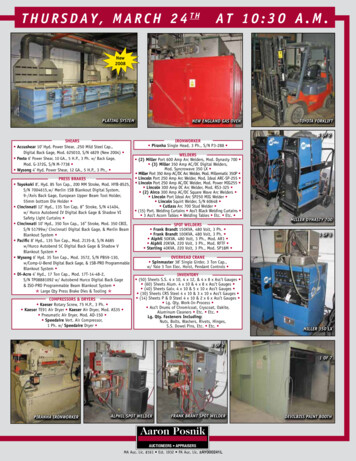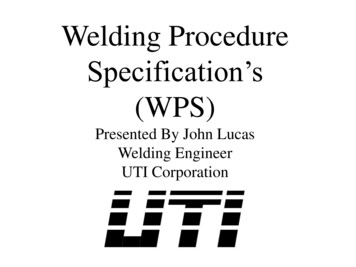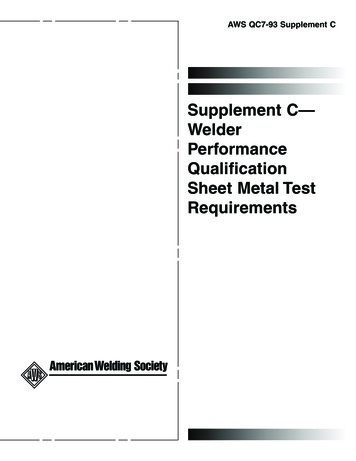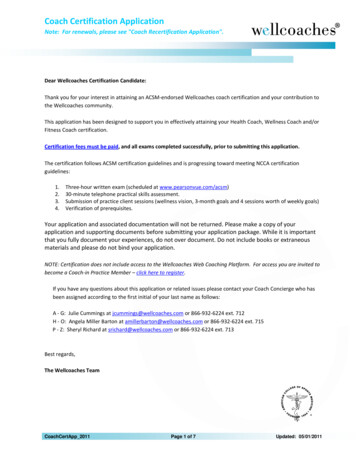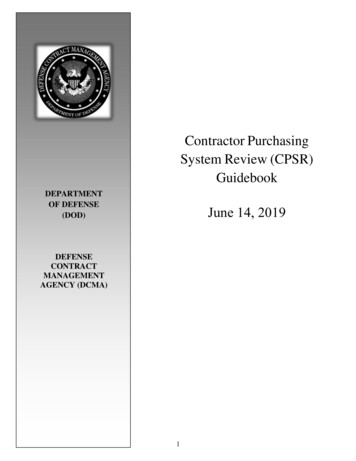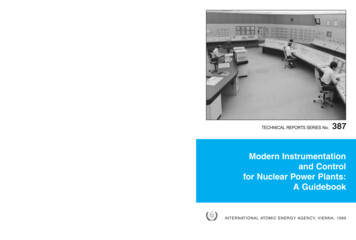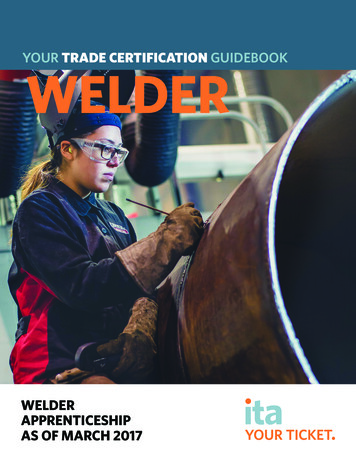
Transcription
YOUR TRADE CERTIFICATION GUIDEBOOKWELDERWELDERAPPRENTICESHIPAS OF MARCH 2017
TABLE OF CONTENTS03Apprentice Responsibilities03Apprenticeship Pathway – Mapping Your Way To Certification04Gaining Competencies Through Work Experience06Standard Level Exams (SLE)06Logbook07Red Seal Inter-Provincial Exam08Final Piece For Your Red Seal Inter-Provincial Certification09Frequently Asked Questions (FAQ)10Financial Support For Apprentices11Apprenticeship Advisor MapYOUR TRADES TRAININGIt’s an exciting time to be in the skilled trades industry! BC is growing and so is the demand for skilledtradespeople in the province. Almost one million jobs are expected to be created by 2025 in BC.With the increasing number of retirees in the trades community, there is a need for more driven individualslike you to pursue careers in trades. From the building you’re sitting in right now to the cars you drove to getthere, there are a number of tradespeople that were involved in the design, creation, and maintenance of them.Congratulations on starting your journey to certification. You are on your way to becoming a key contributorto BC’s trade industry and your community.ABOUT INDUSTRY TRAINING AUTHORITY:The Industry Training Authority (ITA) leads and coordinates British Columbia’s skilled trades system.ITA works with employers, employees, industry, labour, training providers, and government to issuecredentials, manage apprenticeships, set program standards, and increase opportunities in the trades.02 WELDER TRADE CERTIFICATION GUIDEBOOK
APPRENTICE RESPONSIBILITIESWork-Based Hours (WBT) – Reporting your work-based training hours is essential to completing yourApprenticeship. It is your responsibility to confirm with your Sponsor/Employer that your hours havebeen reported to ITA and applied to your Apprenticeship record.If your previous Employer has not submitted work based hours for you, the WBT form allows yourcurrent Sponsor/Employer to sign off those hours.In addition to reporting your hours to the ITA with the Work-Based Hour form, your sponsor willneed to sign off on your processes and competencies in your logbook. You can find a copy of thework-based training form here: loyer – If you have changed your employer it is important to update your Apprenticeshiprecords with this information. Sponsors have the responsibility to sign off work hours and Recommendationfor Certification for completion.Contact Information – It is your responsibility to ensure your contact information is up to date (address,phone, name changes, etc.) This can be done by logging into Direct Access or phoning Customer Service.Direct Access – By logging into Direct Access you can view your Apprenticeship records(transcripts, exam marks, etc). hnical Training Registration – Speak with your employer about when will be a good time for you to goback to school for your next level of technical training. Once you and your employer have agreed on a time,it is your responsibility to register for technical training. A list of Designated Training Providers can be foundhere: www.tradestrainingbc.ca.It is recommended to have the conversation with your employer and register for technical training aheadof time, as classrooms have limited space.APPRENTICESHIP PATHWAY –MAPPING YOUR WAY TO CERTIFICATIONAPPRENTICESHIPDIRECT ENTRYWELDERLEVEL 1Technical Training:240 hours (8 weeks)Work-Based Training:Accumulate hoursLogbook:AccumulatecompetenciesITA StandardizedWritten Exam20%CLASSROOMWELDERLEVEL 2Technical Training:240 hours (8 weeks)Work-Based Training:Accumulate hoursLogbook:AccumulatecompetenciesITA StandardizedWritten Exam80%WORK-BASEDWELDERLEVEL 3Technical Training:300 hours (10 weeks)Work-Based Training:4,620 hours totalLogbook:CompletionInterprovincialRed Seal ExamRECOMMENDATIONFOR CERTIFICATIONCertificate ofQualificationWELDERCertificate ofApprenticeshipWELDERCARPENTER TRADE CERTIFICATION GUIDEBOOK 03
GAINING COMPETENCIESBelow are skills and knowledge you will gain from technical and hands on training.FoundationApprenticecompetenciesTraining Program TechnicalTraining(a.k.a: pre-apprentice)can change. Check Program Outline, link below, for accuracy.(Levels 1, 2, 3, tion/Welder-Outline-oct-2017-harmonized.pdfWELDER LEVEL ONEn Semi-Automatic andFusion and Braze Welding(TB) Using the Oxy-FuelAutomatic WeldingOccupational Skills(OFW)Processn Describe GMAW, GMAW-P,n Describe safe working practicesn Describe fusion welding, brazeFCAW, MCAW and SAWn Perform basic trade relatedwelding and brazing processesprocesses and theirmathematical calculationsand their applicationsapplicationsn Use and maintain measuringn Describe fusion welding,n Describe semi-automaticand layout toolsbraze welding and brazingand automatic weldingn Use and maintain hand toolsequipment and its operationequipment and its operationn Use and maintain power toolsn Describe filler metals, fluxesn Describe filler metal and(electric and pneumatic)and tips used for fusionshielding gases for semin Describe shop materialswelding, braze welding andautomatic and automaticn Apply lifting, hoisting andbrazingprocessesrigging proceduresn Describe joint design andn Use the GMAW andCutting and Gouging Processesweld positions for OFWGMAW-P processesn Describe Oxy-Fuel Cuttingn Fusion weld on low carbonn Use the FCAW process(OFC) processes and theirsteel sheetWelding Drawings,applicationsn Braze weld (TB) using theLayout andFabricationDirect EntryFoundationApprenticeApprenticeSupports*n DescribeOxy-Fuel CuttingApprenticeshipTraining n IdentifyTechnicalOFW processcommon weldingHired and registered by SponsorTraining(a.k.a: pre-apprentice)(OFC) and equipment andwithoutprior Foundation/n Silver alloybrazeonsimilarsymbolsand(Levels1, 2,bolted3, 4)apprentice trainingits operationand dissimilar metalsconnectionsSkills TrainingFundingTuition* and guidedn PerformfreehandShielded Metal ArcSee Notes A CWELDER LEVEL TWOcuts on low carbon steel (OFC)Welding (SMAW)Occupational Skillsn USkillsse automaticand semiIndigenousTraining FundingTuition*n Describe the SMAW processn Apply lifting, hoistingautomaticcutting machines(eligible Indigenousapplicants)n Describe SMAW equipmentISETS agenciesand rigging procedures(OFC)and its operationSee Notes A CShielded Metal Arcn Describe CAC-A and PACn Select electrodes for SMAWWelding (SMAW)processes, equipment andStudent Aid/Loans*n Describe basic joint design andn Select electrodes for SMAWtheir TrainingapplicationsOnly Foundationover 12 weeks longweld positions for SMAWBC ACCESSGrant(onlyfortraininginhighdemandtrades)n Use CAC-A and PAC cuttingn Use the SMAW process on lown Describe weld faults andBursaries and Scholarshipsand gouging processes andcarbon steel plate and pipedistortion in fabrications inequipmentn Describe the SMAW processCanada Apprentice LoanSMAWon grey cast ironn Use the SMAW process on lowWage Subsidy (new hires)*carbon steel plate and pipeWorkBC / ASETS agenciesn Use the hardsurfacing processOther Resources*on low carbon steelSTEPn Use the SMAW process onSee Note Dstainless steel and/or lowEI and AOP: Apprentice Financial Benefitscarbon steel plate and pipefor Apprentice Training *(Apprentice Supports Online Portal)WorkBC04andServiceTRADECanada(for EI-eligibleclients) 2 WELDERCERTIFICATIONGUIDEBOOKTraining Tax Credits Non-Red Seal and Red Seal*
Direct EntryApprenticeshipHired and registered by Sponsorwithout prior Foundation/apprentice trainingFoundationTraining(a.k.a: pre-apprentice)Semi-Automatic andAutomatic Weldingn Use the GMAW andGMAW-P processn Use the FCAW processn Use the MCAW processn Use the SAW processand trades)Gas Tungsten ArcWelding (GTAW)n Describe the GTAW processand its applicationn Describe GTAW equipmentand its operationn Describe the application ofGTAW for ferrous metalsn Use the GTAW processfor ferrous metalsn Use the GTAW processfor stainless steelnts) 2Basic Metallurgyn Describe production processesal*for manufacturing metalsn Describe mechanical andades*physical properties of ferrousand non-ferrous metalsn Describe common ferrous,non-ferrous and reactivemetals and their weldabilityWelding Drawings,ing, and whether or not it is a Red Seal or Non-Red Seal trade.LayoutandFabrications, Victoria Foundation,Bands,bursaries,scholarships, STEPtitutionsn Read and interpret drawingsn several communities to assist Canadians in entering trade careers.als in Trades Trainingand Womenbasicin Trades draftingTrainingn Performn Perform mathematicalcalculationsn Interpret and apply mechanicaldrawings and layoutcomponentsn Fabricate weldmentsn Costing and estimatingApprenticeTechnicalTraining(Levels 1, 2, 3, 4)WELDER LEVEL 3Shielded Metal ArcWelding (SMAW)n Select electrodes for SMAWn Use the SMAW process on lowcarbon steel plate and pipeSemi-automatic andAutomatic Weldingn Use the GMAW andGMAW-P processn Use combined GMAW,MCAW and FCAW processesGas Tungsten ArcWelding (GTAW)n Use the GTAW processfor ferrous metalsn Use the GTAW processfor aluminumBasic Metallurgyn Describe mechanical andphysical properties of ferrousand non-ferrous metalsn Describe common ferrous,non-ferrous and reactivemetals and their weldabilityn Describe the grainstructure of metalsn Describe aluminum, aluminumalloys and their weldabilityWelding Drawings,Layout and Fabricationn Read and interpret drawingsn Interpret and apply mechanicaldrawings and layoutcomponentsn Fabricate weldmentsn Costing and estimatingQuality Control and Inspectionn Describe basic welding qualitycontrol and inspectionrequirementsn Describe inspection and testingproceduresn Describe the scope of thewelding supervisor andinspector responsibilitiesStandards, Codes, Specificationsand Welder Qualificationsn Identify applicable standards,codes, specifications andjurisdictional bodiesn Describe compliance withweld procedure specifications(WPS) and data sheets WELDER TRADE CERTIFICATION GUIDEBOOK 05
STANDARD LEVEL EXAMSStandard Level Exams (SLEs) are usually written on the last day of in-school training and will count for20% of your overall mark.Below is a list for general areas of competencies covered in SLEs for each level.The list of competencies covered in the SLEs can change. Check the Exam Weighting Charts for accuracy at:www.itabc.ca/program/welderLEVEL 1LEVEL 2A. Occupational SkillsA. Occupational SkillsB. Cutting & Gouging ProcessesD. Shielded Metal Arc Welding (SMAW)C. Fusion and Braze Welding (TB)Using The Oxy-Fuel (Ofw) ProcessE. Semi-Automatic and Automatic WeldingD. Shielded Metal Arc Welding (SMAW)H. Basic MetallurgyE. Semi-Automatic And Automatic WeldingI. Welding Drawings, Layout and FabricationF. Gas Tungsten Arc Welding (GTAW)I. Welding Drawings, Layout and FabricationREMINDERSllYou must bring a piece of Government PHOTO identification. The ID must be VALID and CURRENT.Expired IDs and IDs with no expiry date will not be accepted.Your Training Provider will inform you of the time and location of the exam. Arrive early.LOGBOOKWhat is a logbook?Your log book is an important record of your apprenticeship. It is a complete record ofyour technical training, competencies, certifications, endorsements and employmenthistory. It should be presented to employers as proof of your welding qualificationsand experience.While your hours are reported to the ITA via the Work-Based Hour form, your logbookwill record the processes and competencies you have completed. Each section of yourlogbook will be reviewed by ITA to determine if you have met the completionrequirements of your program.When will I receive my Logbook?After you have completed your foundation program or Level 1 technical training,your ITA-approved technical training provider will provide you with the logbook.06 WELDER TRADE CERTIFICATION GUIDEBOOK
RED SEAL INTER-PROVINCIAL EXAMThe Red Seal Inter-Provincial Exam covers a whole range of competencies from all your levels oftechnical training.The table below is a general breakdown of areas of competencies covered in the Red Seal IP exam.The areas of competencies covered in the Red Seal IP exam can change. Check Occupational Standardfor current exams at www.red-seal.ca/trades/w.2ld.2r-eng.html for accuracy.BLOCKA CommonOccupational SkillsTask 1Task 2Task 3Task 4Task 5Uses and maintains tools and equipmentUses access and material handling equipmentPerforms safety-related activitiesOrganizes workPerforms routine trade activitiesBLOCKB Fabrication and Preparationof Components for WeldingTask 6Task 7Performs LayoutFabricates componentsTask 8BLOCKC Cutting and GougingTask 9Task 10Task 11Uses tools and equipment fornon-thermal cutting and grindingUses oxy-fuel gas cutting (OFC) processfor cutting and gougingUses plasma arc cutting (PAC) processfor cutting and gougingUses air carbon arc cutting (CAC-A) processfor cutting and gougingBLOCKD Welding ProcessesTask 12Task 13Task 14Task 15Welds using shielded metal arc welding(SMAW) processWelds using flux core arc welding (FCAW, metal corearc welding (MCAW) and gas tungsten arc welding(GTAW) process.Welds using gas tungsten arc welding (GTAW) processWelds using submerged arc welding (SAW) processNote: Based on the Welder National Occupational Analysis (NOA).A copy of the Welder NOA is available atwww.red-seal.ca/docms/welder noa2014 eng.pdfWELDER TRADE CERTIFICATION GUIDEBOOK 07
FINAL PIECE FOR YOUR RED SEAL INTER-PROVINCIAL CERTIFICATIONOnce you passed your red seal exam these are the next steps:1. Ensure your work-based training hours have been submitted and reached achieved status. Check yourstatus in Direct Access. As a Welder, your sponsor will sign off these hours in your logbook as well asreporting them with the Work-Based Hour form.2. The Recommendation for Certification (RFC) can be found on our website under the forms page. It willneed to be signed by both the Sponsor and a certified Journeyperson. This form must be submitted to theITA with your logbook for assessment. We suggest using registered mail and making copies of your logbookbefore submission: www.itabc.ca/apply-apprenticeship/forms3. ITA will verify and process the RFC, the Certificates will then be printed for mailing.l Certificates are mailed to your Sponsor.l If your Sponsor had indicated on the RFC form to send Certificates to the Apprentice,they will be mailed to the address noted on your Apprenticeship record in Direct chmond,BCV6Y3T6Tel778- ‐328- ‐8700TollFree:1- ‐866- ‐660- ‐6011Fax778- ‐328- ervisionandSign- kaddressinDA. SendtoSponsor ionandSign- visionandSign- ividualwithSupervisorandSign- Name12345AB0108 WELDER TRADE CERTIFICATION GUIDEBOOKProvinceIssued CertificateofQualification ITASign- ‐offAuthority cateorwalletcard.www.itabc.caConnect with usCertificateNumber(below):Page 1SignatureSponsorSignatureF
FAQFREQUENTLY ASKED QUESTIONSHOW DOES MY SPONSOR/EMPLOYER SUBMIT HOURS?The sponsor/employer will submit Work BasedTraining Hours via Direct Access, email, mail, or fax.WHAT IF I WORKED FOR A SPONSOR/EMPLOYER AND THEY DID NOT SUBMITMY HOURS?You can talk to your current sponsor to see ifthey are willing to submit the hours for the workyou did previously on a work based training report.DOES MY SPONSOR/EMPLOYERHAVE TO LET ME GO TO SCHOOL?You need to discuss your plans for school with yoursponsor/employer to see if they are able to releaseyou to go to school. Let them know of upcomingtraining locations and dates.HOW DO I KNOW WHAT MYGRADES ARE FOR SCHOOL?The Trades Training school will submit your marksto ITA. You and your sponsor/employer will receivea notice by email.WHERE DO I GET MYPROGRESSION LETTER?Upon completion of your technical training andrequired work-based hours for Level 1 and 2,ITA will send you the Progression Letter by email.You will need this Progression Letter to apply foryour Apprenticeship Incentive Grant. Please reviewdeadline dates and required number of work placehours at: www.itabc.ca/grants-tax-credits/grantsWHY DO I NEED TO RECORD MYWORK HOURS BOTH ON-LINE ANDIN MY LOGBOOK?WHEN I FINISH MY TRAINING ANDREQUIRED HOURS IN EACH LEVEL,AM I CERTIFIED?No, after you have completed technical training,passed the Certificate of Qualification exam andsubmitted the required WBT hours, you will needto submit your logbook to the ITA for assessment.The logbook must be submitted with the WelderRecommendation for Certification which can befound on our website under the forms page. TheRFC must be signed by a certified tradesperson(same trade) and sent to the ITA with your logbookfor assessment. ITA will send your certificates toyour employer, unless otherwise stated on theRFC form.ARE THERE ANY GRANTS FORFINISHING MY CERTIFICATION?Yes. You can apply for the ApprenticeshipCompletion Grant once you receive your Red SealInter-Provincial Endorsement Certificate. You willneed a copy of your certificate to nt/services/apprentices/grants.htmlARE THERE ANY INCENTIVESFOR MY EMPLOYER?Employers can apply for Tax Credits as theirapprentice progresses through the trade. The taxinformation letter can be found on Direct Access.WHAT IS THE MPAW?The Multi-Process Alloy Welding (MPAW)is an optional endorsement which enables awelder to weld specialized alloys. To register forthis program you must hold the Welder Certificateof Qualification or Welder B with the InterprovincialRed Seal Endorsement.The Work-Based Hour form reports your work hourstowards your apprenticeship completion. Thelogbook records the processes and competenciesyou have completed during those hours. It will alsorecord work history, certificates, and endorsements.Completion of both your hour requirement andlogbook is required for certificationWELDER TRADE CERTIFICATION GUIDEBOOK 09
FINANCIAL SUPPORT FOR APPRENTICESAs a registered apprentice, you can apply for financial support. You’re also eligible to apply for EmploymentInsurance. Federal and provincial financial support information can be found in the two links tice port ing Tuition*See Notes A CIndigenous Skills Training Funding Tuition*(eligibleIndigenousapplicants)Skills TrainingFundingTuition*See NotesA CISETSagenciesDirect EntryApprenticeshipHired and registered by Sponsorwithout prior Foundation/apprentice trainingDirect EntryApprenticeshipHired and registered by Sponsorwithout prior Foundation/apprentice trainingSee Notes A CIndigenous Skills Training Funding Tuition*(eligible IndigenousStudentAid/Loans*applicants)Only FoundationISETSagencies Training over 12 weeks longSeeA CGrant (only for training in high demand trades)BC NotesACCESSBursaries and ScholarshipsStudent an over 12 weeks longBC ACCESS Grant (only for training in high demand trades)Bursariesand ScholarshipsWage Subsidy(new hires)*WorkBC / ASETS agenciesCanada Apprentice LoanOther Resources*STEPWage Subsidy (new hires)*SeeNote D/ ASETS agenciesWorkBCEIand Resources*AOP: Apprentice Financial BenefitsOtherfor Apprentice Training *STEPSee(ApprenticeNote DSupports Online Portal)WorkBC and Service Canada (for EI-eligible clients) 2EI and AOP: Apprentice Financial BenefitsTrainingfor ApprenticeTax CreditsTrainingNon-Red*Seal and Red Seal*Credit(ApprenticeamountSupportsvaries, pleaseOnline referPortal)to CRAWorkBC and Service Canada (for EI-eligible clients) 2Incentive and Completion Grants, Red Seal Trades*TrainingCanadaTax Credits Non-Red Seal and Red Seal*ServiceCredit amount varies, please refer to CRAITA Website Resources* (www.itabc.ca)Incentiveand Completion Grants, Red Seal neReporting Trade ProfileITA Website Resources* (www.itabc.ca)DirectAccessNote A: WorkBC and EPBC. Indigenous resources: ISETS agencies, Victoria Foundation, Bands, bursaries, scholarships, STEPNote B: ApprenticeshipBursaries may be availablethrough individualOnlineReportingTrade trainingProfileinstitutions*Support is dependent on eligibility and varies by trade, level of training, and whether or not it is a Red Seal or Non-Red Seal trade.Note C:Note D:ACE IT/SSA coordinated through School DistrictsSkilled Trades Employment Program (STEP) is available in several communities to assist Canadians in entering trade careers.Programs include Immigrants in Trades Training, Aboriginals in Trades Training and Women in Trades Training*Support is dependent on eligibility and varies by trade, level of training, and whether or not it is a Red Seal or Non-Red Seal trade.Note A:Note B:Note C:Note D:WorkBC and EPBC. Indigenous resources: ISETS agencies, Victoria Foundation, Bands, bursaries, scholarships, STEPBursaries may be available through individual training institutionsACE IT/SSA coordinated through School DistrictsSkilled Trades Employment Program (STEP) is available in several communities to assist Canadians in entering trade careers.Programs include Immigrants in Trades Training, Aboriginals in Trades Training and Women in Trades Training10 WELDER TRADE CERTIFICATION GUIDEBOOKFoundationTraining(a.k.a: pre-apprentice)ApprenticeTechnicalTraining(Levels 1, 2, 3, 4)FoundationTraining(a.k.a: pre-apprentice)ApprenticeTechnicalTraining(Levels 1, 2, 3, 4)
NOTESWELDER TRADE CERTIFICATION GUIDEBOOK 11
CONNECT WITH US!www.itabc.caCONTACT EMAIL OR CALL778.328.8700 or call TOLL FREE in BC: 1.866.660.6011customerservice@itabc.caOur customer experience representatives are accessible, from 8:00 a.m. to 4:30 p.m. PT, Monday toFriday, and can provide you with quick and easy access to information regarding all of ITA’s services.Call or email us today for information on training and apprenticeship, including registration,examinations and certification, or to answer any other questions you may have.CONNECT LOCALLYLooking for someone to help you in your community? ITA has regional Apprenticeship Advisors acrossthe province to support local skilled trades apprentices and employers. Find the ApprenticeshipAdvisor closest to you—all you need is your postal code.Do you want to learn more about how ITA works with industry? Feel free to contact any of our IndustryRelations Team to better understand each industry’s needs in BC and to learn more about how they areworking to ensure we have the right skilled workers where they are needed.VISIT CUSTOMER CENTREITA’s Customer Support Centre8th Floor – 8100 Granville Avenue, Richmond, BC V6Y 3T6We are happy to serve you in-person at our Richmond Customer Support Centre, and through ourregional Apprenticeship Advisors, who are available to serve you in communities across the province.SUBSCRIBE TO TRADES TALKKeep up to date on ITA in action as well as other trades and industry news bysubscribing to our quarterly newsletter, Trades Talk.Industry Training Authority@ita bc@ita bcITA BC2018 Edition
Welding Drawings, Layout and Fabrication nTr Identify common welding symbols and bolted connections WELDER LEVEL TWO Occupational Skills n Apply lifting, hoisting and rigging procedures Shielded Metal Arc Welding (SMAW) n Select electrodes for SMAW n Use the SMAW process on low carbon ste


